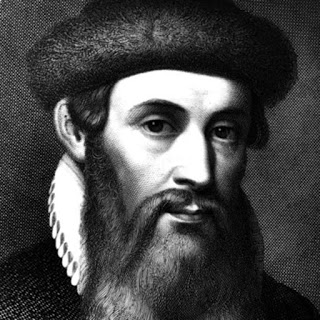German inventor Johannes Gutenberg developed a method of printing from movable type. He printed the first book via movable type, the Forty-Two-Lines Bible.
Johannes Gutenberg was born 1395, in Mainz, Germany. He started experimenting with printing by 1438. He obtained backing in 1450 from the financier Johann Fust, whose impatience and other factors led to Gutenberg’s loss of his establishment to Fust in 1455. Gutenberg’s masterpiece, and the first book ever printed from movable type, is the Forty-Two-Lines Bible, completed no later than 1455.

Born into a modest merchant family in Mainz, Germany, in 1395, Johannes Gutenberg’s work as an inventor and printer would have a major impact on communication and learning worldwide. He was the third son of Freile zum Gensfleisch and his second wife, Else Wirick zum Gutenberg, whose maiden name Johann later adopted. There is little recorded history of this early life, but local records indicate he apprenticed as a goldsmith while living in Mainz.
 When a craftsman revolt erupted in Mainz against the noble class in 1428, Johannes Gutenberg’s family was exiled and settled in Strasburg, where his experiments with printing began. Already familiar with bookmaking, Gutenberg perfected small metal type. Infinitely more practical than carving complete wood blocks for printing, each type was a single letter or character. Movable type had been used in Asia hundreds of years earlier, but Gutenberg’s innovation was developing a casting system and metal alloys which made production easier.
When a craftsman revolt erupted in Mainz against the noble class in 1428, Johannes Gutenberg’s family was exiled and settled in Strasburg, where his experiments with printing began. Already familiar with bookmaking, Gutenberg perfected small metal type. Infinitely more practical than carving complete wood blocks for printing, each type was a single letter or character. Movable type had been used in Asia hundreds of years earlier, but Gutenberg’s innovation was developing a casting system and metal alloys which made production easier. In 1448, Johannes Gutenberg moved back to Mainz and by 1450 was operating a print shop. He had borrowed 800 guilders from local financier Johan Fust to purchase specific tools and equipment needed for his unique typography method. By December, 1452, Gutenberg was heavily in debt and unable to pay Fust’s loan. A new agreement was drawn up making Fust a partner in Gutenberg’s business. By 1455, Gutenberg was still unable to pay the debt and Fust sued. Court records are sketchy, however scholars believe that while the trial was going on, Gutenberg was able to print his masterpiece, the 42-Line Bible, also called the Gutenberg Bible.

Fust won the suit and took over most of Johannes Gutenberg’s printing business including the production of the Bibles. Peter Schoeffer, Gutenberg’s son-in-law who had testified against him during the trial, now joined Fust as a partner in the business. In addition to the Bible, Gutenberg’s other major achievement was the Psalter (the book of Psalms) which was also given to Fust as part of the settlement. The Psalter is decorated with hundreds of 2-color initial letters and delicate scroll borders using an ingenious method based on multiple inking on a single metal block. The Psalter was the first book to display the name of its printers, Fust and Schoffer, but historians believe that neither could have developed such a sophisticated method alone and that Gutenberg must have been working for the pair in the business he once owned.
In 1462, Mainz was sacked by Archbishop Adolph II in a dispute over control of the city. Fusta and Gutenberg’s printing businesses were destroyed. Many of the city’s topographers fled to other parts of Germany and Europe taking their techniques and technology with them. Gutenberg remained in Mainz but once again fell into poverty. The Archbishop granted him the title of Hofmann (gentleman of the court) in 1465, which provided a salary and privileges for services rendered. Gutenberg carried on his printing activities for several more years, but little evidence exists of what he actually published because he didn’t put his name on any of his printings.
Records of Johannes Gutenberg’s later years are as sketchy as his early life. Still living in Mainz, it is believed that he went blind in the last months of his life. He died on February 3, 1468, and was buried in the church of the Franciscan convent in the nearby town of Eltville, Germany.
For more details visit www.photostop.in or Contact Us @ 9845128760






